
In a world where sustainability is becoming a focal point, eco-friendly home decor is more than just a trend—it’s a lifestyle choice that reflects our growing consciousness about the environment. But what does it mean to incorporate eco-friendly products into your home, and how can it transform your space into a sanctuary of both style and sustainability? Let’s dive in.
Gone are the days when eco-friendly was synonymous with drab and boring. Today, the market is brimming with stylish, chic, and affordable options that don’t compromise on aesthetics or ethics. The secret lies in understanding materials and choosing products that align with your environmental values. From reclaimed wood furniture to organic cotton throws, the possibilities are endless.
One of the most popular materials in sustainable decor is bamboo. It grows quickly, requires minimal resources, and is incredibly versatile. You’ll find bamboo in everything from flooring to furniture to kitchen utensils. Its light, natural color fits seamlessly into any decor style, offering a modern, minimalist look.
Another sustainable option is recycled glass. When turned into vases, candle holders, or even tiles, recycled glass adds a unique touch to your home. Each piece carries its own history, often sporting subtle variations in color and texture that tell a story. These products not only reduce waste but also add an element of charm and character to your space.
Textiles play a significant role in home decor, and choosing sustainable options can make a big difference. Organic cotton, linen, and hemp are excellent choices. They are not only biodegradable but also produced with fewer chemicals, making them better for the environment and your health. These materials are perfect for cushions, curtains, and bed linens, adding a touch of comfort and warmth to any room.
Incorporating plants into your home is another way to embrace eco-friendly decor. They purify the air, add life to your space, and can even improve your mood and productivity. Opt for easy-to-care-for varieties like succulents or snake plants if you’re new to plant parenting.
DIY projects are another fantastic way to go green. Upcycling old furniture, for instance, can give a second life to items you might otherwise discard. A fresh coat of eco-friendly paint or new hardware can transform a piece entirely, saving money and reducing waste.
When shopping for eco-friendly decor, look for certifications like Fair Trade, Global Organic Textile Standard (GOTS), and Forest Stewardship Council (FSC). These labels ensure that the products are made ethically and sustainably.
In conclusion, eco-friendly home decor is not just about the products you choose but the mindset you adopt. It’s about valuing quality over quantity, embracing the beauty of natural imperfections, and creating a space that reflects your commitment to the planet. By making conscious choices, you can transform your home into a stylish sanctuary that feels as good as it looks. Whether you’re just starting your eco-friendly journey or looking to enhance your existing decor, remember that every small change makes a big impact.